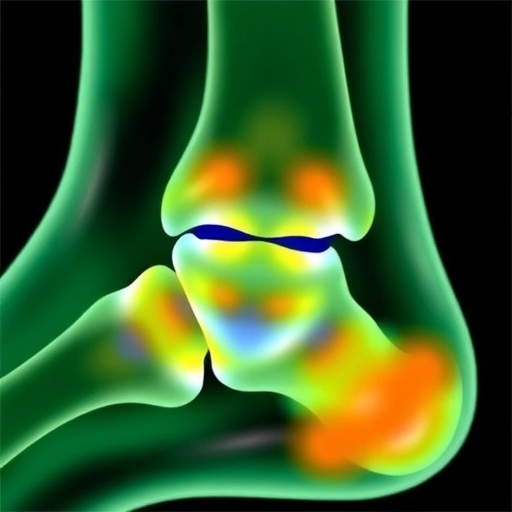In an era where the intricacies of joint health and diseases such as osteoarthritis are increasingly central to medical research, a groundbreaking study has emerged that promises to redefine our understanding of articular cartilage permeability. A team of researchers led by Dr. Liang Gao of the National University has developed a novel permeability-sensing device specifically designed for articular cartilage. This innovative technology not only enhances diagnostic capabilities but also offers exciting prospects for personalized medicine in orthopedic care.
Articular cartilage, the smooth tissue covering the ends of bones in a joint, plays a crucial role in facilitating frictionless movement and absorbing shock during physical activity. Understanding the permeability of this tissue is vital for diagnosing and monitoring joint health. When cartilage becomes permeable, it can lead to the deterioration of this essential tissue, ultimately resulting in conditions like osteoarthritis. Therefore, the demand for an accurate, reliable means to assess cartilage permeability has never been more pressing.
The researchers undertook a meticulous design process for their permeability-sensing device, beginning with a comprehensive review of existing technologies. By identifying gaps in current methodologies, they aimed to establish a device that not only achieved high sensitivity in detecting permeability changes but also demonstrated ease of use in clinical settings. The device is compact, portable, and user-friendly, an essential feature for widespread clinical adoption.
The development phase included rigorous validation studies to ascertain the accuracy and reliability of the permeability measurements. The research team conducted both in vitro and in vivo experiments, verifying that the device consistently provided reliable data across a range of cartilage samples. These validation efforts involved comparing the device’s measurements with established standards and benchmarks, ensuring that the results would hold up under scrutiny in clinical trials.
The preliminary clinical evaluation of the device marked a significant milestone in the study. A diverse patient population was recruited to assess the device’s practicality in real-world settings. Patients underwent a series of tests where the device was employed to measure the permeability of cartilage tissue in various joints. The outcomes were promising, with the device successfully capturing crucial data that had eluded clinicians previously.
Patients expressed optimism regarding the device’s potential to provide timely insights into their joint health. Feedback highlighted not only the device’s accuracy but also its ability to deliver results quickly, facilitating informed decision-making for treatment pathways. As chronic joint conditions can significantly impact patients’ quality of life, the implications of this technology are profound and widespread.
The device operates on the principle that changes in the permeability of articular cartilage can be linked to increased fluid movement through the tissue. By utilizing sophisticated sensors and algorithms, the device is capable of quantifying these permeability changes with remarkable precision. The real-time data generated can lead to proactive management strategies, potentially altering the course of treatment for patients at risk of developing debilitating joint diseases.
It is noteworthy that the device’s design incorporates a non-invasive methodology, setting it apart from other diagnostic tools that often require invasive procedures. This non-invasive approach minimizes patient discomfort and opens doors to more widespread use in clinical settings, as practitioners can perform assessments without subjecting patients to unnecessary risks. Ease of access to accurate diagnostics is a key advantage that could revolutionize joint health monitoring.
As the research team looks to move beyond preliminary evaluations, they are already considering the integration of this technology into broader clinical protocols. The data collected could be invaluable in refining treatment protocols, allowing healthcare providers to tailor interventions based on individual patient profiles. This shift towards personalized medicine stands to enhance outcomes for countless individuals suffering from joint-related ailments.
The implications of this study extend beyond the immediate benefits of the device itself. It paves the way for further research into the mechanisms underlying cartilage health and disease. By exploring the intricacies of tissue permeability further, scientists might uncover critical pathways and targets for novel therapeutics aimed at preventing cartilage degradation.
Collaborations with orthopedic specialists are also on the horizon, as the researchers aim to partner with healthcare professionals for large-scale clinical trials. The ultimate goal is to establish the device as a standard tool in orthopedic practices across the globe, thus democratizing access to cutting-edge diagnostic capabilities. This cooperation could catalyze a paradigm shift in how clinical practitioners approach joint health monitoring and treatment.
Dr. Gao and his team have ambitious plans for the future, envisioning that the findings from their study will serve as a foundation for additional innovations in cartilage regenerative medicine. As technology advances and research expands, the dream of restoring damaged cartilage may be within reach. The potential to translate this permeability-sensing technology into regenerative therapies could provide hope for millions who suffer from chronic joint pain.
As this pioneering research continues to unfold, the scientific community remains eager to witness the outcomes of larger trials and the device’s eventual integration into regular clinical practice. The sense of anticipation surrounding the technology reflects a growing awareness of the need for innovative solutions to longstanding medical challenges.
In conclusion, the development of a permeability-sensing device for articular cartilage may herald a new dawn in the field of orthopedics. By offering unprecedented insights into cartilage health and disease, this groundbreaking technology holds the potential to improve patient outcomes, enhance personalized treatment strategies, and ultimately change the landscape of joint health management. With continued dedication to research and collaboration, the dream of improved joint health may soon become a reality for many individuals suffering from the burden of joint diseases.
Subject of Research: Development of a Permeability-Sensing Device for Articular Cartilage
Article Title: A Permeability-Sensing Device for Articular Cartilage: Design, Validation, and Preliminary Clinical Evaluation
Article References:
Gao, L., Meng, X., Sun, Y. et al. A Permeability-Sensing Device for Articular Cartilage: Design, Validation, and Preliminary Clinical Evaluation.
J. Med. Biol. Eng. 45, 416–424 (2025). https://doi.org/10.1007/s40846-025-00954-3
Image Credits: AI Generated
DOI: 10.1007/s40846-025-00954-3
Keywords: Articular cartilage, permeability, diagnostic device, osteoarthritis, personalized medicine, joint health, clinical evaluation, non-invasive technology.




